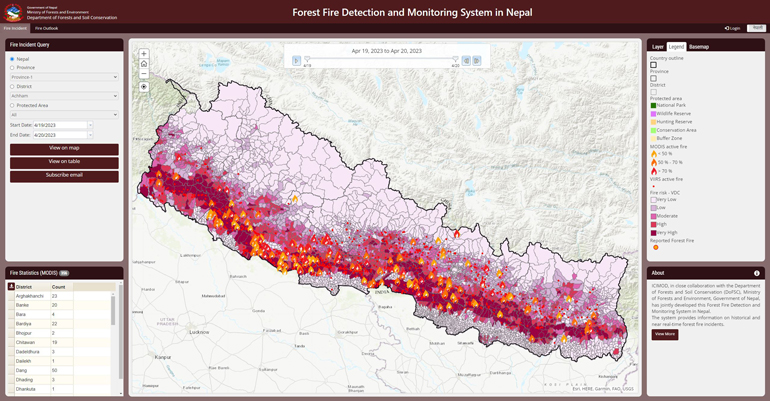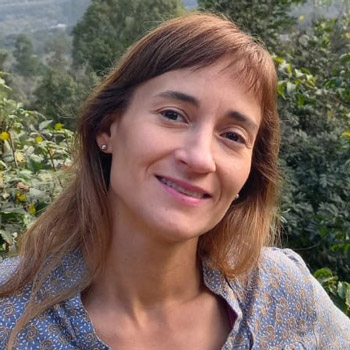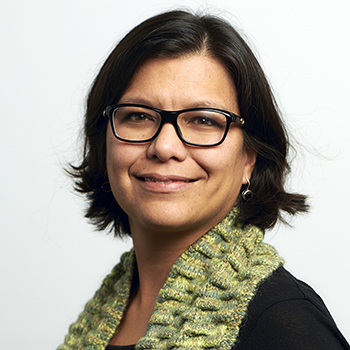Systematic observation of the social-ecological dimensions of mountain areas can help us understand the social, environmental, economic, and cultural dynamics and trends affecting mountain communities and ecosystems. This MRD Talk brought together researchers, practitioners, and policymakers to learn from diverse ongoing monitoring initiatives. We jointly explored how best to set up monitoring systems and share the information generated in order to enable effective policies and action for sustainable futures in mountains.
Monitoring of mountain systems can be defined as the integrated and systematic observation of interactions among people, ecosystems, and environments within mountain systems, and between mountains and other systems. Monitoring can be used to quantify the signals of change in socioeconomic and environmental characteristics of mountain systems and should be delivered rapidly and ideally in near real time. It is key to understanding and supporting actions aimed at addressing development and livelihood challenges and to identifying opportunities for innovation on a scientifically supported basis (Shahgedanova et al 2021).

Participants in the MRD Talk responded to the question “What aspects should be monitored to guide action and policies for sustainable future in mountains?” The breadth of the answers shows how challenging it is to set up monitoring systems that can integrate all these diverse indicators.
MRD author Julieta Carilla, research scientist at the Instituto de Ecología Regional, Universidad Nacional de Tucumán and at the Consejo Nacional de Investigaciones Científicas y Técnicas (CONICET) in Yerba Buena, Tucumán, Argentina, stressed the need to integrate socioeconomic and biophysical dimensions for the long-term monitoring of social-ecological systems. In their study published in MRD, Carilla and colleagues developed a model for assessing monitoring efforts in the Andes and identified priorities for future research. They found that a vast majority of monitoring initiatives in the region focused on climate and other biophysical aspects, whereas social aspects remained poorly monitored. They also found that efforts involving comanagement, participatory management, and codesign remained scarce. In terms of a research agenda, the group identified four priority topics that need to be better addressed in order to realize the full potential of monitoring efforts in the Andes to support policy and action: (1) social-ecological systems’ stakeholders, economies, natural elements, and their interactions, (2) global drivers of change, (3) accessibility of data and information, and (4) governance and coordination of monitoring efforts. In line with the findings of this study, researchers and institutions have created the Network of Socio-ecological Observatories (ROSA), which integrates Andean monitoring efforts into observatories.
The second panelist, Valentin Wallnöfer, researcher at the Center for Advanced Studies of Eurac Research in Bolzano, Italy, shared experiences from the Sustainable Tourism Observatory of South Tyrol, which is one of 38 observatories in the International Network of Sustainable Tourism Observatories of the United Nations World Tourism Organization (UNWTO). The observatory’s main objective is to support the local tourism industry and the regional government in developing policies, strategies, and management processes for sustainable tourism. It engages in monitoring, reporting, and networking activities. Examples of indicators monitored include the environmental impact of tourism in South Tyrol, its economic benefits, as well as cultural and social aspects, such as local and visitor satisfaction with tourism development. Relevant findings are shared with stakeholders in different forums, and results are reported in publicly available annual reports, in scientific as well as practice- and policy-oriented publications, and on the observatory’s website.
Another specific illustration of the crucial importance of monitoring systems in mountains was given by Birendra Bajracharya, Chief of Party for the SERVIR Hindu Kush Himalaya initiative at the International Centre for Integrated Mountain Development (ICIMOD) in Kathmandu, Nepal. He presented a system for the detection and monitoring of forest fires that was established jointly by SERVIR Hindu Kush Himalaya and the Department of Forest and Soil Conservation of Nepal. The system was developed gradually, starting from forest fire incident mapping and alerts based on MODIS active fire data in 2013, then incorporating historical data to identify particularly high-risk areas, and finally producing a forest fire hazard outlook component based on a fire weather index. Today, the forest fire monitoring system offers a basis for understanding the spatial and temporal patterns of forest fires in Nepal, provides daily, spatially disaggregated information on fire-prone areas, enables community forest user groups to take preventive measures before the start of the fire season, and serves to alert relevant local agencies to high hazard risks.

Forest fire risk mapping is an important component of SERVIR Hindu Kush Himalaya’s Forest Fire Detection and Monitoring System in Nepal. The darker the shade of pink, the higher the fire risk.
James Thornton, Senior Scientific Project Officer at the Mountain Research Initiative in Bern, Switzerland, rounded off the panel presentations with a contribution on GEO Mountains, the Global Network for Observations and Information in Mountain Environments. GEO Mountains is an initiative of the Group on Earth Observations (GEO), itself a partnership of over 100 governments and over 100 participating organizations. GEO Mountains aims to improve the discoverability and accessibility of data and information on mountains worldwide, to integrate and apply such data and information for scientific, policy, and practical impact, and to build, connect, coordinate, and share capacity across a collaborative community of mountain researchers, practitioners, and policymakers from different regions and disciplines. GEO Mountains’ assessment shows that there is considerable monitoring infrastructure in mountains, but at this point the collated metadata on these sites remain incomplete. In addition, in many cases the data produced are not yet freely shared. GEO Mountains is working to improve this situation and also conducts policy-oriented research and produces a range of documentation for both decision-makers and scientists.
The panel presentations were followed by an interactive session, where the MRD Talk’s participants were asked to reflect on what needs to be improved for monitoring systems to contribute to actions and policies for sustainable futures in mountains. As an input for the discussion, the panelists’ recommendations had been grouped into the following 4 topics: (1) data and knowledge, (2) access to information, (3) competences and resources, and (4) communication and learning. With regard to data and knowledge, one participant voiced the need for a stronger focus on adaptive monitoring. Other needs mentioned included a more balanced representation of world regions, standardized protocols, consistency, and intercomparability across regions and scales. Regarding access to information, James Thornton explained how GEO Mountains is working to build a superinventory of data portals, ultimately aiming at a system where decentralized datasets could be accessed and updated in real time from different nodes. MRD Talk participants called for governments to promote the use of open-source standards and stressed the importance of open science in the sense of making both the monitoring data and the methodologies used openly available and freely usable in accessible formats. The discussion around communication and learning focused on the use of communication tools not just to share results, but also to collect data from local communities, practitioners, and visitors. Participants also highlighted the need to integrate different types of knowledge, including that of Indigenous and local communities or of mountain guides. Concerning the topic of competences and resources, participants stressed the importance of collaboration and coordination among projects and stakeholders in order to tap synergies and make better use of resources.
MRD associate editor Sarah-Lan Mathez-Stiefel concluded the event by highlighting some key ideas that emerged from the presentations as well as the discussion:
- There is a need to better integrate socioeconomic and biophysical data and to counterbalance the bias towards biophysical aspects. It is also important to connect different scales and bring local concerns to the regional and global levels. Producing knowledge that is both locally relevant and globally intercomparable is a challenge.
- Much remains to be done with regard to open science and free access to data and methodologies, including making different datasets accessible from a joint entry point.
- The presentations on the sustainable tourism observatory of South Tyrol and the forest fire detection and monitoring system in Nepal provided successful practical examples of how to strengthen the interaction between science and policy. Generally, however, tailored communication remains a challenge for many monitoring initiatives and needs to be further improved.
- All panelists emphasized the need for collaboration among diverse stakeholders, not only in carrying out the actual monitoring activities but also in translating the knowledge into action on the ground. Participants also contributed interesting thoughts on the use of participatory monitoring, citizen science, and the inclusion of local knowledge.
Panelists
Moderators
Resources
Long-term social-ecological monitoring in the Andes
- Carilla J, Aráoz E, Osinaga Acosta O, Malizia A, Malizia M, Jimenez Y, Peralvo M, Garces A, Lasso G, Llambí LD. Long-term environmental and social monitoring in the Andes: State of the art, knowledge gaps, and priorities for an integrated agenda. Mountain Research and Development 43(2):A1–A9.
- Andean Network of Socio-ecological Observatories (ROSA) website
Forest fire detection and monitoring in Nepal
- Forest Fire Detection and Monitoring System in Nepal web page
- Thapa S, Chitale VS, Pradhan S, Shakya B, Sharma S, Regmi S, Bajracharya S, Adhikari S, Dangol GS. 2021. Forest fire detection and monitoring. In: Bajracharya B, Thapa RB, Matin MA, editors. Earth Observation Science and Applications for Risk Reduction and Enhanced Resilience in Hindu Kush Himalaya Region. Cham, Switzerland: Springer, pp 147–167.
- Matin MA, Chitale VS, Murthy MSR, Uddin K, Bajracharya B, Pradhan S. 2017. Understanding forest fire patterns and risk in Nepal using remote sensing, geographic information system and historical fire data. International Journal of Wildland Fire 26:276–286.
Sustainable Tourism Observatory of South Tyrol
- Sustainable Tourism Observatory of South Tyrol web page
- Regional Tourism Development Concept 2030+ project page
- International Sustainable Tourism Observatories Network web page
GEO Mountains
- GEO Mountains website
- GEO Mountains Inventory of In Situ Observational Infrastructure
- The Mountains Uncovered Series: Intercomparable Maps and Statistics for 100 Selected Global Mountain Ranges (v1.0)
- Thornton JM, Palazzi E, Adler C. 2022. Mountain Observations: Monitoring, Data, and Information for Science, Policy, and Society. Policy Brief. Bern, Switzerland: GEO Mountains.
- Thornton JM, Palazzi E, Pepin NC, Cristofanelli P, Essery R, Kotlarski S, Giuliani G, Guigoz Y, Kulonen A, Pritchard D, et al. 2021. Toward a definition of Essential Mountain Climate Variables. One Earth 4(6):805–827.
- Thornton JM, Pepin N, Shahgedanova M, Adler C. 2022. Coverage of in situ climatological observations in the world’s mountains. Frontiers in Climate 4.
- Shahgedanova M, Adler C, Gebrekirstos A, Grau HR, Huggel C, Marchant R, Pepin N, Vanacker V, Viviroli D, Vuille M. 2021. Mountain observatories: Status and prospects for enhancing and connecting a global community. Mountain Research and Development 41(2):A1–A15.








